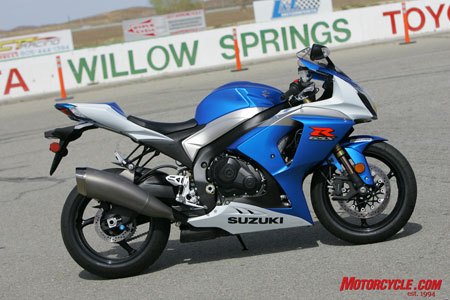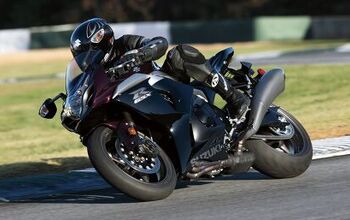2009 Suzuki GSX-R1000 Review - Motorcycle.com
Get the Flash Player to see this player.
Whether or not this smacks of some rightly deserved aloofness will be up to you: Essentially, Suzuki perceived the task of crafting its new liter-class missile as a challenge in delivering a bike with the performance to exceed “… its biggest rival – the current GSX-R.”
The phrase “total balance” is bandied about routinely in press materials for the new bike. Integral to achieving this target of perfect symbiosis between powerplant and chassis, the 999cc mill is now all-new. Much of the engine’s re-make conforms to the mandate set forth by Suzuki that “close-to-ideal” chassis dimensions are the driving force behind the heavily re-vamped liter bike.
A New Engine for a New Gixxer Thou
In addition to fostering chassis development goals, the more compact engine design was also influenced by “increased performance potentials as a base engine for racing competitions.” Gee, wonder if Suzuki wants to keep winning championships?
| Here’s a brief look at the myriad changes in the engine: | |
| • Bore and stroke increased to 74.5 mm x 57.3mm (73.4mm x 59.0mm in ‘08). The more over-square (shortened stroke) design equates to slower piston speeds at the unchanged 13,750-rpm rev limiter. | |
| • Piston diameter increased by 1.1mm; longer (0.5mm) connecting rods receive shot-peen treatment for increased strength. | |
| • Compression ration up to 12.8:1 versus 12.5:1 from 2008 model. | |
| • New crankshaft-end lubrication system – first ever on a production 4-cylinder Suzuki – increases lubrication efficiency equating to reduced mechanical losses; the counter-balance shaft diameter reduced by 3mm also reduces mechanical losses. | |
| • Intake port is larger “to realize cylinder-head construction suited to modification for higher revving.” Read: better suited for race tuning | |
| • New camshafts; relocation of cam-angle sensor to middle of camshaft translates into shorter camshaft length equating to a lighter camshaft. | |
| • Ti intake and exhaust valves are both 1mm larger than previous and employ dual springs, rather than a single spring; exh. valve angle is decreased by 0.5 degree to 12.5 degrees. | |
| • New crankcase is now 2-piece instead of 3-piece, and has improved venting; transmission countershaft was repositioned from forward the driveshaft to directly overtop resulting in a reduction of over 2 inches between crank and drive shafts. New 2-piece case design and stacked tranny aid in creation of more compact engine; primary reduction ratio increased a smidge while final reduction ratio decrease a bit, all to better capitalize on improved drive out of corners. | |
| • Slipper-clutch was refined and joined by new one-piece clutch/starter cover that saves a claimed 200 grams; equally as important was the switch from hydraulic to cable-actuated clutch for improved feel, according to Suzuki materials. | |
| • Race-developed radiator is now narrower and lighter; new oil cooler also is narrower and provides better heat dissipation. | |
| • On the fuel-induction front: airbox outlet funnel is now plastic rather than rubber for weight savings, and the air funnel length can be shortened by 10mm for racing applications. Throttle body length is 5mm shorter via a new attachment to the airbox; SRAD (Suzuki’s ram-air system) intake has been repositioned closer to the bike’s centerline for improved intake efficiency. Suzuki’s PAIR (Pulsed-Air) system (pumps clean air into exhaust ports, largely an emissions thing) is now more compact. | |
| • All-new MotoGP-inspired exhaust system uses titanium cans and is claimed to shave 400 grams of unnecessary weight; the stainless-steel under-chamber contains the catalyzer. | |
| • Finally, the new Thousand uses iridium-tip spark plugs (just like its little brother, Gladius), and the ECU was redesigned for weight savings. | |
A new chassis: the kingpin of GSX-R evolution
In the cutthroat realm of sportbikes, a supremely powerful engine is often the paramount motivator ensuring a good shot at winning championships, both at the track and in the showroom. But making effective use of the impressive horsepower available on current literbikes usually generates a whole new set of challenges.
To that end, Suzuki has crafted a new twin-spar aluminum frame. Of course weight reduction came about, but so did a wheelbase now 10mm shorter. For us in the U.S. that difference looks like this: 55.3 inches vs. 55.7 inches. However, swingarm length increased by 32mm via the reduction in engine length. The objective behind the new swingarm is twofold: retain stability via reduced rear suspension squat, and increase rear tire traction. Rake and trail have increased barely perceptible amounts.
Attention given the new engine and new frame might’ve gone unrivaled if it weren’t for the use of Showa Corporation’s big newsmaker, the Big Piston Fork, or more commonly, BPF. The BPF was developed from top-level road racing events over the past few years, and a race-application iteration was used to great success by Suzuki in recent Suzuka 8-Hour events. The BPF is relatively new to production motorcycles: its only other placement thus far is on the 2009 Kawasaki ZX-6R in 41mm flavor, while the Gixxer Thou’s BPF has larger 43mm stanchions.
By using a much larger main piston in place of the cartridge system with smaller piston traditionally used in most modern sportbike’s front suspension, a reduction of damping pressure via increased piston surface area/volume is possible. The result is less dive under braking, reduced high-speed compression harshness and overall better feel. Also, eliminating fork internals means weight loss; 720 grams less compared to the ’08 GSX-R1000 front end.
The shock remains mostly unchanged, but shock linkage was altered for greater progressiveness aiding improved traction and is lightened by way of extruded aluminum alloy rather than forged construction. The electronically controlled steering damper received revisions in the form of increased damping force at higher speeds, reduced damping at low speeds, and lost some weight with the now-hollow damper rod.
Spinning at both ends are new, lighter wheels carrying grippy and consistent-wearing Bridgestone BT-016 tires tailored specifically for the new liter-capacity Suzuki. Hauling in the flagship GSX-R from speed is the duty of all-new mono-block radial-mount Tokico calipers pinching new 310mm rotors; the new binder package saves hundreds of grams, naturally.
According to Suzuki staff, claimed wet weight for 2009 is 6 lbs less than last year. Published figures have the 2008 GSX-R1000 scaling in between 473-475 lbs wet.
Like any pretty girl who just shed pounds following a rigorous diet plan, the venerable Suzuki superbike needed a new look. From a distance the 2009 model looks very similar to last year, but closer inspection reveals a new headlamp design followed by a narrower tailsection with redesigned LED taillamps, and a trimmer fuel tank maintains ’08 fuel capacity of 4.6 gallons. Mirrors are updated for improved visibility a la reduced vibration and greater ease-of-adjustment.
Of these styling updates, an all-new instrument panel is likely the most appreciable change. The new clocks prominent alterations include a more visible A-B-C display from S-DMS (Suzuki-Drive Mode Selector) and a new programmable 4-bulb shift light system as opposed to the single shift light from last year. The new shift light system incorporates three yellow bulbs that light sequentially leading to a larger final white light. Adjustable rpm settings for the lights can be made in 250, 500 and 1,000 rpm increments.
While we’re near the subject of S-DMS, the selectable mapping system’s switch has been relocated, from the right clip-on switch gear to a new location on the left switch gear, for less-complicated operation while riding. What was formally the location of S-DMS toggles on the right is now occupied by a switch that toggles through the numerous functions of the new instrument panel. S-DMS access is now comprised of two trigger-style switches, one at the index finger and one at the thumb; both triggers scroll through A-B-C modes.
Wind protection is still good (or as good can be noted on a track), ergos are essentially unaltered and re-styled footpegs remain 3-way adjustable over a 14mm vertical and horizontal range.
Proof in the GSX-R pudding
Circulating “The Big Track” at Willow Springs International Raceway in Rosamond, CA, is where U.S. moto-journos would taste-test the new bike.
Apparent right out of the gate is how potent a mill it is that powers the ground-up revamp of the GSX-R. It seems to pull with unmitigated grunt right off idle, but my seat-o’-the-pants dyno detected a notable ramping up of power around the 7K mark. From that point, all the way to rev-limit, speed builds not only ferociously, but in an exceptionally linear manner. Fueling on this day was flawless with instant throttle response available anywhere.
The salient point in all this talk of the engine is that despite the incredible rate at which power, and subsequently speed, builds, managing it is easier than ever. The new Gixxer Thou’s tremendous torque and wicked acceleration is wonderfully tractable, likely due to chassis updates as well as numerous engine updates aimed at linear power.
As wowed as I was by the engine, the chassis’ user-friendly character also caught my attention early on. From turn-in to turn completion, the bike is compliant and ever-obedient, as it rolls easily from left to right. Alterations in trajectory, or say, increasing lean angle, are always predictable. And even if the bike does get out of shape, bringing it back in-line isn’t an exercise in blind faith. Tell the bike where you need it to be and it’ll be there, probably quicker than you anticipate. I couldn’t help but be left with the impression that the Suzuki’s handling is just as linear as is its power.
Once preload in the BPF fork was backed out a couple turns from initial settings for my 155 -lb frame, the front-end did an excellent job of telegraphing everything that was happening. Indeed, front-end dive under braking is minimal and good stability is a hallmark of the new Suzi. The new mono-block brake calipers provide heaps of easily modulated power, making for a perfect fit in the overall GSX-R1000 package.
Though we had plenty of lap time, the race track doesn’t always exhibit real-world conditions, so street environs may reveal issues not perceived at 140 mph. Nevertheless, 2009 GSX-R1000 gave me no significant fault-finding points of interest.
The best I can do is remark on the slightly sticky tranny that would, on occasion, resist high-speed/high-rpm clutchless upshifts. In reality, this minute trouble is probably more a function of a brand new, and thusly stiff, gearbox more than it is some inherent woe, as Suzuki transmissions are typically excellent. The only other niggle is that the point of engagement on the new cable-actuated clutch seems to happen rather early in lever release. No big deal.
We’ll get more seat time on this overhauled Suzuki in our annual literbike battle, but for now it seems the goal of making the 2009 GSX-R1000 a bike with “total balance” has largely been realized.
Bikes are making their way to dealers now. They’ll come in Black/Matte Black, Red/Black (the red is really more Maroon), and of course traditional GSX-R Blue/White, all at the MSRP of $12,899.
More by Pete Brissette




































Comments
Join the conversation